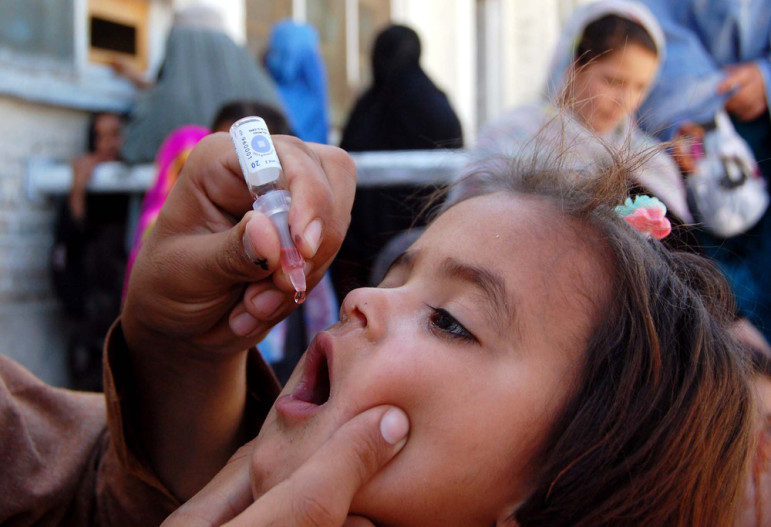
October 17, 2015; The Lancet
After all the bad news about the continuing problem of Ebola, including its persistence in the fluids of some people who thought they had been cured of the disease, there is good news on a different health front. The beleaguered World Health Organization reports that the number of polio-endemic countries is now down to two, as there have been no cases of polio in Nigeria over the last 12 months.
The Lancet attributes this in part to the Global Polio Eradication Initiative (GPEI), launched in 1988 when polio was still paralyzing 350,000 children in 125 countries every year. Last year, the number of new cases of polio dropped to 359, basically a decrease of 99 percent from the start of the GPEI. In the current round of GPEI funding for 2014–2016, donor countries and private donors pledged a little over $4 billion toward the GPEI funding target of $5.5 billion. So far, about $1.9 billion of the pledges have been converted from pledge to real cash. As an indication of the power and influence of philanthropic capital, the following chart shows the largest donor pledges from the 2013 Global Vaccine Summit and the largest confirmed cash payments as of December 2014:
Sign up for our free newsletters
Subscribe to NPQ's newsletters to have our top stories delivered directly to your inbox.
By signing up, you agree to our privacy policy and terms of use, and to receive messages from NPQ and our partners.
| Largest donor pledges | Amount pledged | Largest confirmed donor financial commitments | Amount committed |
| Bill and Melinda Gates Foundation | $1,800 million | Bill and Melinda Gates Foundation | $411.65 million |
| United Kingdom | $457 million | United Kingdom | $297.64 million |
| Other foundations and high net worth individuals (combined) | $335 million | United States (pledge was only $90.6 million) | $226.05 million |
| Norway | $252.45 million | Norway | $182.05 million |
| Canada | $243.53 million | Rotary International (pledge of $76.81 million toward a 2013-2018 pledge of $175 million, to be matched 2:1; Gates match counted as Gates) | $160 million |
| Islamic Development Bank/Gov’t of Pakistan | $227 million | Islamic Development Bank/Gov’t of Pakistan | $137.28 million |
| Germany | $151.7 million | Canada | $102.72 million |
Several things are interesting about the Lancet article. One is that ridding the world of polio has proven to be expensive. So far, $11.3 billion (of which $1.1 billion came from polio-affected countries) has been spent toward the GPEI since 1988. In comparison, the Lancet reports, ridding the world of smallpox (“the first and only human disease to have been eradicated”) cost only $280 million. Moreover, it took 14 years to eradicate smallpox, while the target date for eradicating polio looks likely to be shifted from 2018 to 2019 at a minimum. Experts are cautious about declaring victory in any case, since in 2012, after cases of polio had dropped, the next two years saw large increases in several countries. It is a “rocky road to zero,” according to the independent monitoring board that tracks progress against the disease.
Second, the two remaining countries with polio are Pakistan and Afghanistan. Of the “wild poliovirus cases” reported in the world last year, 85 percent were in Pakistan, which the Lancet says is actually exporting polio cases to Afghanistan. The instability caused by warfare is a problem for eradicating polio, especially in areas such as Iraq, Syria, Somalia, and Yemen, as well as Pakistan and Afghanistan, where there has been recent substantial displacement of refugees and consequent population movement. It goes to show that technical or vaccine solutions to a disease like polio can be undone by factors that aren’t treatable by vaccines. The 700,000 children who have not yet been vaccinated in Afghanistan and Pakistan reflect the difficulty of reaching populations in conflict zones.
The third interesting dynamic is the significance and prominence of the Bill and Melinda Gates Foundation among the other large donors, including national governments. The resources that the Gates Foundation can apparently devote to this and other health problems is larger than what national governments and multilateral organizations can do. One might question who sets the agenda. In most of life, it’s money that talks, so when it comes to an international health mission with an emphasis on developing and making available vaccines known to work against polio, it’s easy to imagine a private foundation with assets larger than some countries’ GDPs is in a position to not only help with solutions but to help set the agenda in general.—Rick Cohen













